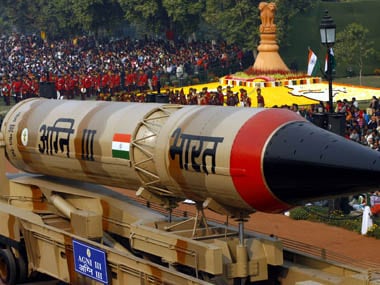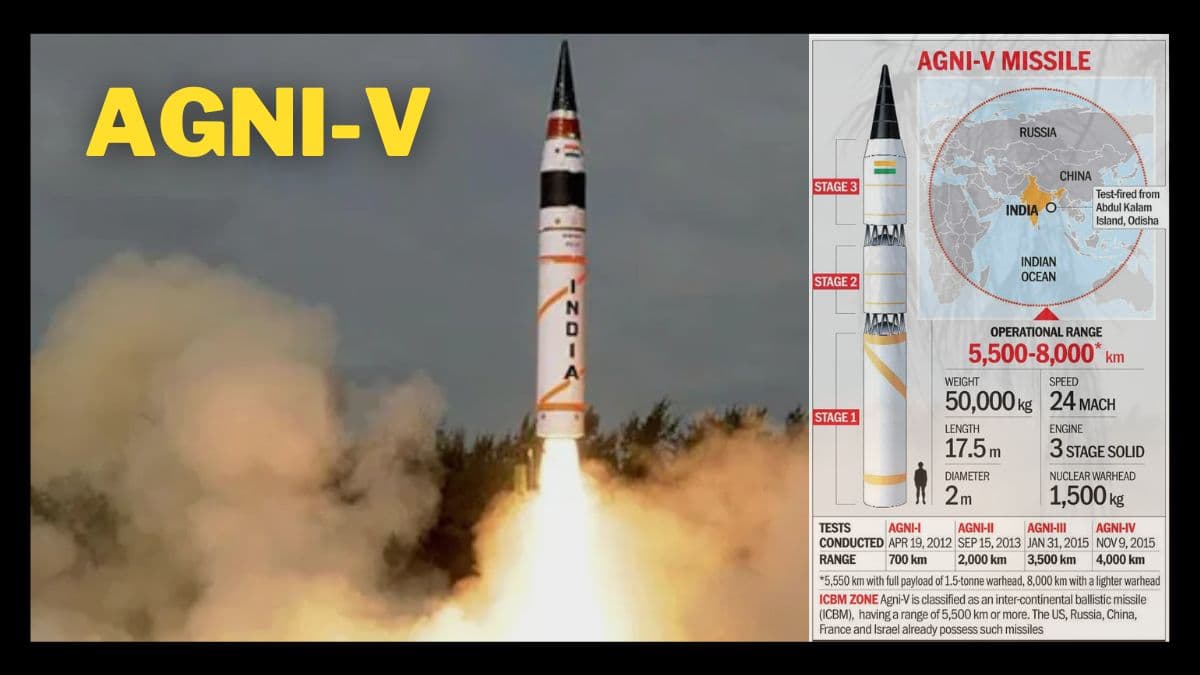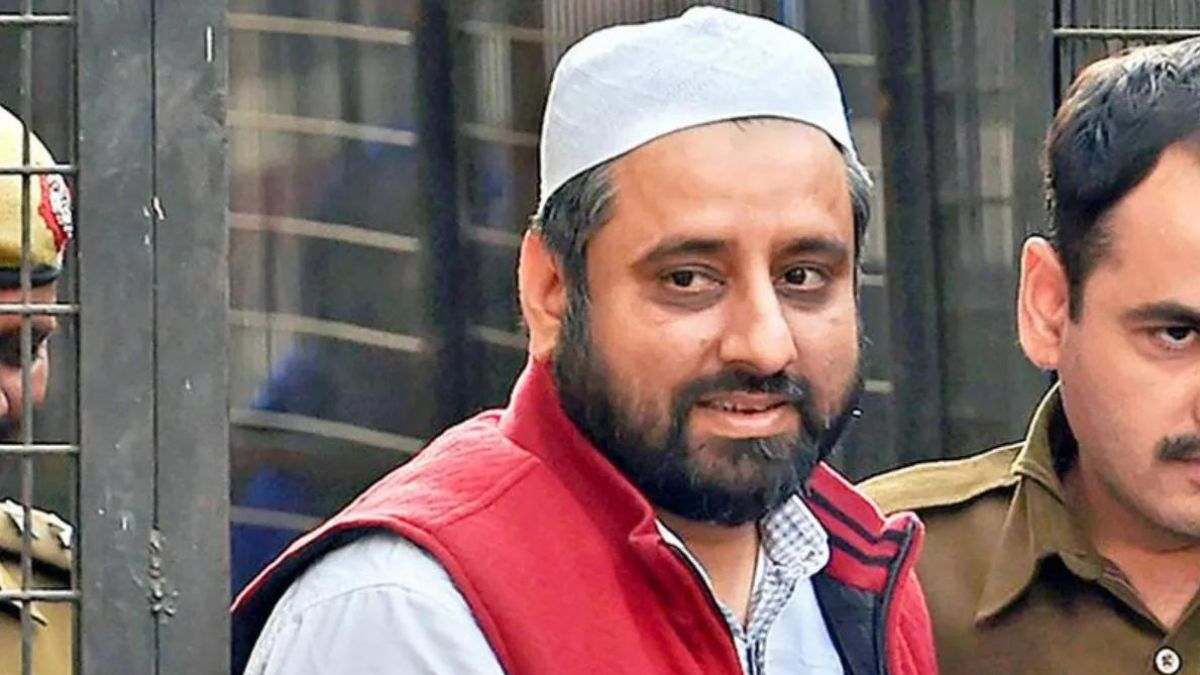Agni-5 Missile: India’s Fiery Reach
The Agni-5 missile, a titan in India’s missile arsenal, has captured global attention. This blog delves deep into this powerhouse, exploring its capabilities, significance, and future implications.

What is the Agni-5 Missile?
The Agni-5, meaning “Fire” in Sanskrit, is a land-based, nuclear-capable Intercontinental Ballistic Missile (ICBM) developed by the Defence Research and Development Organisation (DRDO) of India. This marvel of Indian engineering boasts an impressive range exceeding 7,000 kilometers, placing it firmly in the ICBM category.
Agni-5 Missile: Capabilities Unveiled
The Agni-5’s capabilities are truly formidable:
- Intercontinental Range: With a range exceeding 7,000 kilometers, the Agni-5 can potentially reach targets across continents, significantly enhancing India’s strategic deterrence.
- Three-Stage Propulsion: The Agni-5 utilizes a powerful three-stage solid-fueled engine, offering greater efficiency and faster launch times compared to liquid-fueled missiles.
- High Accuracy: The Agni-5 boasts a sophisticated guidance system, ensuring precise targeting and increased effectiveness.
- Road Mobility: Mounted on a mobile launcher, the Agni-5 offers greater operational flexibility and survivability against potential attacks.
- Nuclear Capability: The Agni-5 can be equipped with nuclear warheads, solidifying India’s position as a major nuclear power.
Agni-5 Launch Video: Witnessing the Power
The successful test launches of the Agni-5 have been a testament to India’s technological prowess. Several videos showcasing these launches are available online (insert “Agni-5 launch video” link here). Witnessing the fiery spectacle of the Agni-5 taking flight provides a powerful visual representation of its capabilities.
The Significance of the Agni-5 Missile
The Agni-5 holds immense significance for India:
- Deterrence: The Agni-5 strengthens India’s deterrence capability by posing a credible threat to potential adversaries.
- Strategic Autonomy: The successful development of the Agni-5 reduces India’s reliance on foreign missile technology, fostering greater strategic independence.
- Technological Advancement: The Agni-5 represents a significant leap forward in Indian missile technology, showcasing the country’s growing capabilities in this critical domain.
- Global Recognition: The Agni-5 has garnered international attention, placing India at the forefront of missile development and solidifying its position as a major military power.
Agni-5 Missile: A Look at the Competition
India’s Agni-5 program exists within a global context of advanced missile technology. Here’s a glimpse at some key players:
- United States: The US possesses a vast arsenal of ICBMs, including the Minuteman III with a range exceeding 13,000 kilometers.
- Russia: Russia boasts a formidable ICBM force, including the RS-28 Sarmat with an intercontinental range.
- China: China has actively developed its ICBM capabilities, with the DF-41 possessing a potential range exceeding 12,000 kilometers.
While the Agni-5’s range puts it in the same league as these missiles, continuous development is crucial for India to maintain its strategic edge.
The Future of the Agni-5 Program
The future of the Agni-5 program is likely to focus on:
- Range Enhancement: Efforts might be directed towards extending the Agni-5’s range for even greater strategic deterrence.
- Accuracy Improvement: Continuous advancements in guidance systems could further enhance the missile’s pinpoint accuracy.
- Multiple Independently Re-entry Vehicle (MIRV) Capability: Integrating MIRV technology, allowing the Agni-5 to carry and deploy multiple warheads, could be a future development.
These advancements would solidify the Agni-5’s position as a cornerstone of India’s missile defense strategy.
Beyond the Agni-5: India’s Missile Arsenal
The Agni-5 represents just one facet of India’s growing missile arsenal. Other notable programs include:
- Agni series: The Agni series encompasses a family of missiles with varying ranges, catering to diverse strategic needs.
- Prithvi series: These short-range ballistic missiles are meant for tactical battlefield applications.
- BrahMos: This Indo-Russian joint venture produces supersonic cruise missiles with devastating capabilities.
India’s comprehensive missile development program ensures a layered defense system and strengthens its position as a major military power in the region.
The Agni-5: A Deeper Dive
Building upon the foundation laid, let’s delve deeper into the Agni-5 missile, exploring its technical aspects, strategic implications, and potential future developments.
Under the Hood of the Agni-5
The Agni-5’s impressive capabilities stem from a blend of cutting-edge technologies:
- Solid-Fueled Propulsion: Unlike liquid-fueled missiles requiring extensive pre-launch preparation, the Agni-5 uses solid fuel, allowing for faster launch times and increased operational readiness. This solid fuel is also believed to be a composite propellant, offering greater efficiency and range compared to conventional solid fuels.
- Three-Stage Design: The Agni-5 utilizes a three-stage propulsion system. Each stage ignites sequentially, progressively propelling the missile towards its target. This multi-stage design allows the Agni-5 to achieve its remarkable intercontinental range.
- Ring Laser Gyroscope Inertial Navigation System (RLG INS): A sophisticated RLG INS serves as the Agni-5’s primary guidance system. This system employs lasers and gyroscopes to determine the missile’s position and orientation with exceptional accuracy, ensuring it reaches its intended target precisely. Additionally, the Agni-5 might be equipped with GPS or NavIC for supplemental guidance.
- Road Mobile Launcher: Mounted on a highly mobile launcher, the Agni-5 enjoys greater operational flexibility. This mobility allows for rapid deployment to various launch sites, making it a more challenging target for potential adversaries.

The Strategic Significance of the Agni-5
The Agni-5’s capabilities translate into significant strategic advantages for India:
- Nuclear Deterrence: Possessing an intercontinental ballistic missile with a nuclear warhead capability strengthens India’s deterrence posture. This capability discourages potential adversaries from engaging in a full-scale conflict with India.
- Credible Second Strike Capability: The Agni-5’s mobility and survivability contribute to a credible second-strike capability. Even if an adversary launches a surprise attack, India could potentially retaliate with a devastating nuclear strike using the Agni-5.
- Enhanced Regional Influence: The Agni-5 program showcases India’s growing technological prowess and military strength. This advancement bolsters India’s position as a major regional power and influences the geopolitical landscape in Asia.
The Agni-5 and International Relations
The development and deployment of the Agni-5 have international ramifications:
- Impact on Regional Balance of Power: The Agni-5’s capabilities alter the regional balance of power in Asia. Neighboring countries, particularly Pakistan and China, might perceive it as a threat and potentially accelerate their own missile development programs.
- Arms Control Discussions: The Agni-5, along with other nuclear advancements, could reignite discussions on arms control treaties and non-proliferation initiatives in the region. India’s stance on these discussions will be crucial in shaping the future of nuclear security in Asia.
- Global Missile Defense Systems: The Agni-5’s capabilities might prompt other countries, especially those with advanced missile defense systems like the US and Russia, to further refine their defensive technologies.
The Agni-5 and the Future
As India continues to refine its missile technology, the future of the Agni-5 program holds promise for further advancements:
- Range Extension: Efforts might be directed towards extending the Agni-5’s range even further. This could involve advancements in propellant technology or the addition of booster stages.
- MIRV Capability: Integrating Multiple Independently Re-entry Vehicle (MIRV) technology could allow the Agni-5 to carry and deploy multiple warheads, significantly increasing its destructive potential. However, such developments might raise international concerns about nuclear proliferation.
- Accuracy Enhancement: Continuous research and development in guidance systems could further improve the Agni-5’s pinpoint accuracy, ensuring even greater effectiveness.
These potential advancements underscore India’s commitment to strengthening its missile defense capabilities and maintaining a credible deterrent against potential threats.
Beyond the Battlefield: The Civilian Applications of Missile Technology
The technologies developed for the Agni-5 program have broader applications beyond the military realm. Here are some examples:
- Satellite Launch Vehicles: The expertise gained in developing and launching the Agni-5 could contribute to India’s space program, potentially leading to the development of more powerful and efficient satellite launch vehicles.
- Disaster Management: The Agni-5 program’s advancements in high-precision navigation and guidance systems could be adapted for civilian applications like disaster management and emergency response.
- Material Science: Research in developing high-performance materials for the Agni-5 could benefit other sectors like aerospace and infrastructure development.
The Agni-5: A Force to be Reckoned With
The Agni-5 and Public Perception
The development and deployment of the Agni-5 program have generated public discourse within India and abroad. Here’s a closer look at some key perspectives:
- National Security: Many Indian citizens view the Agni-5 as a critical element of national security, deterring potential threats and bolstering India’s position as a major power. The program is seen as a symbol of India’s self-reliance in defense technology.
- Economic Costs: Developing and maintaining advanced missile systems like the Agni-5 come at a significant financial cost. Some argue that these resources could be better allocated towards social welfare programs and economic development.
- Arms Race Concerns: The Agni-5 program, coupled with advancements in other countries’ missile technology, raises concerns about a potential arms race in Asia. This could destabilize the region and divert resources away from other pressing issues.
Open discussions and a balanced approach are crucial for navigating these complex considerations.
The Ethical Dimension of Nuclear Deterrence
The concept of nuclear deterrence, a cornerstone of the Agni-5’s strategic purpose, raises ethical questions. Here are some points to ponder:
- The Threat of Mutually Assured Destruction (MAD): Nuclear deterrence relies on the threat of MAD, where both sides in a conflict possess the capability to inflict devastating damage on each other. This raises concerns about the ethical implications of potentially unleashing such destructive forces.
- Non-Proliferation Efforts: The development of the Agni 5, while promoting national security, could be seen as a step back from global efforts towards nuclear non-proliferation. India’s commitment to international treaties and responsible nuclear stewardship is crucial.
- The Pursuit of Peaceful Solutions: Ultimately, the most desirable path is to resolve international conflicts peacefully through diplomacy and dialogue. Continuous efforts towards disarmament and arms control remain essential.
The Agni 5 and India’s Strategic Future
The Agni 5 missile stands as a potent symbol of India’s growing technological prowess and strategic ambitions. Its capabilities enhance India’s deterrence posture and influence the regional balance of power in Asia. However, the development and deployment of such advanced weaponry are not without their complexities.
Moving forward, India faces the challenge of balancing its security needs with promoting regional stability and pursuing peaceful resolutions to international conflicts. Responsible stewardship of nuclear technology and continued engagement in global non-proliferation efforts will be crucial for India’s future on the world stage.
The Agni 5 program serves as a springboard for further advancements in Indian missile technology, with potential civilian applications and broader strategic implications. As India continues to refine its missile capabilities, the world will be watching with a keen eye on the role the Agni 5 plays in shaping the country’s future.
The Agni 5 missile has captivated the world’s attention, showcasing India’s growing technological prowess. This land-based, nuclear-capable Intercontinental Ballistic Missile (ICBM) boasts an impressive range exceeding 7,000 kilometers, solidifying India’s position as a major military power.
Capabilities Unveiled
The Agni 5’s strength lies in its formidable features:
- Intercontinental Range: Reaching targets across continents, it significantly enhances India’s strategic deterrence.
- Three-Stage Propulsion: Utilizing a powerful solid-fueled engine, it offers faster launch times and greater efficiency.
- High Accuracy: A sophisticated guidance system ensures precise targeting and effectiveness.
- Road Mobility: Mounted on a mobile launcher, it offers greater operational flexibility and survivability.
- Nuclear Capability: Equipable with nuclear warheads, it strengthens India’s nuclear deterrence.
Significance for India
The Agni 5 holds immense value:
- Deterrence: It strengthens India’s ability to deter potential adversaries.
- Strategic Autonomy: Reduced reliance on foreign missile technology fosters greater strategic independence.
- Technological Leap: It signifies a significant advancement in India’s missile technology.
- Global Recognition: It places India at the forefront of missile development, solidifying its position as a major military power.
A Look at the Competition
India’s Agni 5 program exists within a global context of advanced missile technology. Key players include:
- United States: Possessing ICBMs like the Minuteman III with a range exceeding 13,000 kilometers.
- Russia: Boasting a formidable ICBM force, including the RS-28 Sarmat with an intercontinental range.
- China: Actively developing ICBMs, with the DF-41 potentially exceeding 12,000 kilometers.
The Future of Agni 5
The program’s future likely focuses on:
- Range Enhancement: Extending the Agni 5’s range for even greater deterrence.
- Accuracy Improvement: Continuously enhancing the guidance system for pinpoint accuracy.
- MIRV Capability: Integrating MIRV technology to carry and deploy multiple warheads.
Beyond the Agni 5: India’s Missile Arsenal
The Agni 5 represents just one facet of India’s growing missile arsenal, including:
- Agni Series: A family of missiles with varying ranges catering to diverse strategic needs.
- Prithvi Series: Short-range ballistic missiles for tactical battlefield applications.
- BrahMos: A joint Indo-Russian venture producing supersonic cruise missiles with devastating capabilities.

The Agni 5 and Public Perception
The program has generated public discourse:
- National Security: Many view it as critical for national security and self-reliance.
- Economic Costs: Concerns exist regarding the significant financial resources required.
- Arms Race: The program, coupled with advancements by other countries, raises arms race concerns.
The Ethical Dimension
The concept of nuclear deterrence poses ethical questions:
- Mutually Assured Destruction (MAD): The threat of MAD raises concerns about unleashing such destructive forces.
- Non-Proliferation: Development of the Agni 5 could be seen as a step back from global efforts.
- Pursuit of Peaceful Solutions: Continuous efforts towards disarmament and arms control remain essential.
Conclusion: A Force Shaping India’s Future
The Agni 5 stands as a symbol of India’s strategic ambitions. While it enhances deterrence and influences regional power dynamics, India faces the challenge of balancing security needs with promoting regional stability and pursuing peaceful resolutions. Responsible stewardship of nuclear technology and continued engagement in global non-proliferation efforts will be crucial for India’s future on the world stage. The Agni 5 program serves as a springboard for further advancements, shaping not only India’s military capabilities but also its strategic influence in the years to come.
Resources:
- https://en.wikipedia.org/wiki/Agni-V
- https://timesofindia.indiatimes.com/india/mission-divyastra-pm-modi-announces-first-flight-test-of-made-in-india-agni-5-missile/articleshow/108397658.cms
- https://www.hindustantimes.com/india-news/agni5-gets-multiple-warheads-capability-101710181316478.html
- https://www.ndtv.com/india-news/as-india-preps-for-missile-test-chinese-vessel-on-watch-off-vizag-coast-5218406
- https://www.businesstoday.in/visualstories/news/mission-divyatra-from-agni-1-to-agni-5-here-is-how-indias-nuclear-missile-has-evolved-since-its-inception-112868-12-03-2024
For more news: https://waddupindia.in/






